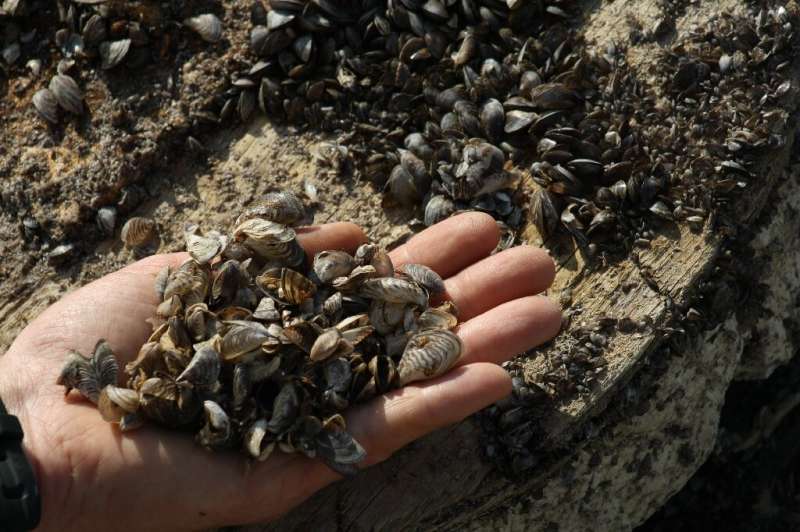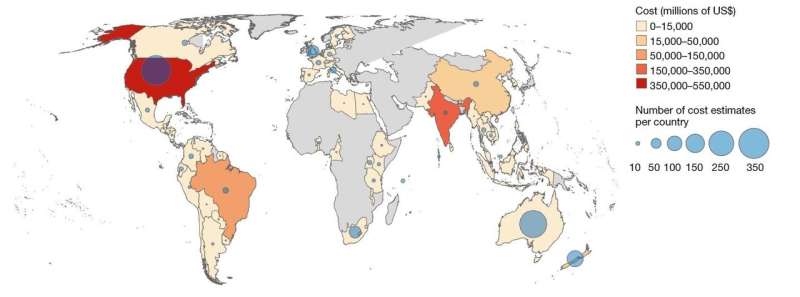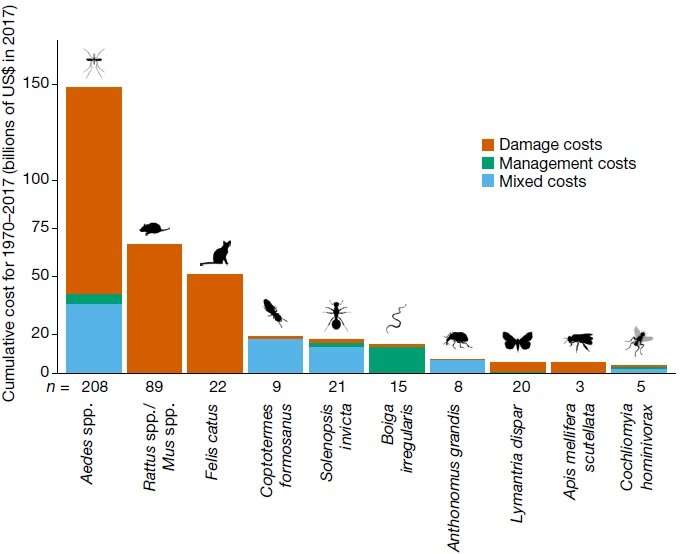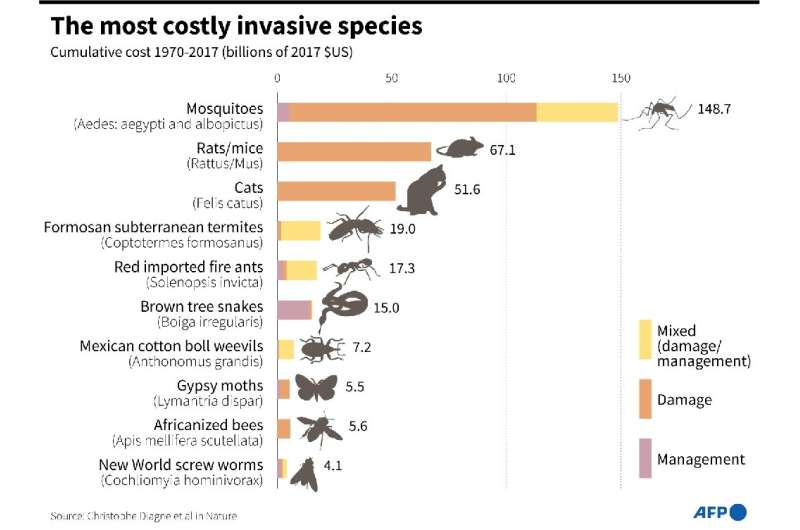
This is a huge problem and there is littlev we can do about it. Do not forget we also invaded the original stable land over the past two centiries in particular. We eliminated the apex species to do that.
what is happening is locals have expanded and foreign critters have also showed up.
None of this has completely settled out as my generation largely left the land and the acerage coverage has dropped off hugely. Thus deer are no longer scarce and turkeys and wild pigs are invading everywhere.
Ultimately this has to be addressed. It will demand the use of natural refugia in particular and eventuall we will need to use time gap worm holes as well for island refugia.
Snakes, rats and cats: the trillion dollar invasive species problem
by Amélie Bottollier-Depois
MARCH 31, 2021
https://phys.org/news/2021-03-us128-trillion-stark-economic-carnage.html
Zebra mussels were introduced into North America by accident
Disease-carrying mosquitoes, crop-ravaging rodents, forest-eating insects and even the domestic cat are all "exotic" intruders whose cost to humanity and the environment is vast and growing, according to a sweeping study published Wednesday.
Researchers in France estimate that invasive species have cost nearly $1.3 trillion dollars to the global economy since 1970, an average of $26.8 billion per year.
And they warn that this is likely an underestimate.
In a study published in the journal Nature, scientists totted up the dizzying array of harmful effects from species carried between habitats, whether plants, insects, reptiles, birds, fish, molluscs, micro-organisms or mammals.
Beyond the "phenomenal magnitude" of these costs, there is also sign of a steady upward trend since 1970, said lead author Christophe Diagne, of the Ecology, Systematics and Evolution laboratory at the University of Paris-Saclay.
Most of the price tag is associated with the damage to ecosystems, crops or fisheries, although pest-control measures were also included in the research, an analysis of hundreds of studies that are part of a new invasive species database.
A preliminary roundup of the top ten invasive pests includes crop-eating rats and the Asian gypsy moth, which is attacking trees throughout the northern hemisphere.

Geographical distribution of the cost estimates (in millions of 2017US dollars) available in the most robust subset of the original database forthe period of 1970-2017. We included only estimates that could be derived fora single geographical region (Africa, Asia, Central America, Europa, NorthAmerica, Oceania and the Pacific Islands, and South America) or country. Credit: Nature
It also included the tiger mosquito, native to Southeast Asia, which has become one of the worst invasive species in the world, carrying diseases like chikungunya, dengue and zika.
Average annual costs triple every decade, researchers said, in part because of an increase in scientific studies on this subject.
But there is also evidence of an "exponential increase in introduced species, due to growing international trade," said Franck Courchamp, director of the same Paris-Saclay laboratory.
"We import lots of species, voluntarily or involuntarily," he said.
Musseling in
It is a problem with a long history, linked to human trade, travel and colonialism.
In Australia, feral European rabbit populations were first reported in the early 1800s and their population exploded, reaching such proportions that they ravaged native species and caused billions of dollars of damage to crops.

The 10 costliest taxa from the most robust subset of the originaldatabase for both cumulative damage and management costs (in millionsof 2017 US dollars) between 1970 and 2017. Each bar represents a species or acomplex of species (when different species were often consideredsimultaneously to provide cost estimates). Numbers below the bars indicatethe number of cost estimates. This ranking illustrates the limits of the availabledata and the need for more thorough and standardized cost reports(Supplementary Discussion 1). All animal silhouettes were obtained from anopen source platform (http://phylopic.org/). The silhouette of Coptotermeswas created by Melissa Broussard; the silhouette of Bursaphelenchus xylophiluswas created by Gareth Monger. Credit: Nature
In 1950, the government released the disease myxomatosis, which only affects rabbits, killing over 90 percent of the wild bunnies. But some have since built up immunity.
The brown tree snake has eaten nearly all of the native birds and lizards of Guam since it was accidentally introduced in the mid-twentieth century from its South Pacific habitat, as well as causing power outages by infiltrating electrical installations and menacing people in their homes.
In the 1980s and 90s the zebra mussel, which originated in the waterways of the former Soviet Union, invaded North America's Great Lakes, blocking pipes, threatening native species and causing billions in damages.
On land, American forests—and more recently those in Europe—have been devastated by the Asian long-horned beetle.
While in Hawaii, the Puerto Rican coqui frog has found a new home with no natural predators—except local homeowners whose property values have tumbled thanks to its ear-splitting croak, which can reach 100 decibels.

Temporal trend of global invasion costs (in millions of 2017 USdollars) between 1970 and 2017. The solid line represents the temporaldynamics of costs based on a linear regression (see Extended Data Fig. 2 andSupplementary Methods 1 for details). The dashed line connects the meanannual costs for each decade and the horizontal dotted line indicates the meanannual cost for the entire period (see Methods, 'Approach based on availableestimates' for details). The horizontal bars indicate the total time span overwhich decadal mean costs were calculated. The last three years (displayed astriangles) were not included in the model calibration; they are data-deficientand probably contribute to the artefactual decrease in global costs during thepast decade (Supplementary Methods 1). We considered 1,319 cost estimatesfrom the original database after successive processing steps (seeSupplementary Data 1).Fig. 2 | Temporal trends of global damage and management costs (inmillions of 2017 US dollars) based on both mean annual costs for eachdecade and model prediction between 1970 and 2017. Damage compriseseconomic losses due to direct and/or indirect impacts of invaders, such as yieldloss, illness, land alteration, infrastructure damage or income reduction.Management includes economic resources allocated to actions to avoid theinvasion or to deal with more or less established invaders such as prevention,control, research, long-term management or eradication. Regression lineswere obtained by robust regression to minimize the effect of outliers(Supplementary Methods 1). Note that the error bands represent the 95%confidence intervals. The last three years (displayed as triangles) were notincluded in the model calibration. We considered 1,287 cost estimates (n = 402estimates for damage costs; n = 878 estimates for management costs) from theoriginal database (see Supplementary Data 1). Credit: Nature
'Incalculable'
Researchers hope that by putting a number on the cost of invasive species they can raise awareness of the enormity of the problem and push it higher on humanity's daunting list of environmental challenges.
But beyond the monetary estimate, the study said the "ecological and health impacts of invasions are at least as significant, yet often incalculable".
The UN's science advisory panel for biodiversity, called IPBES, has said invasive species are among the top five culprits—all human-driven—of environmental destruction worldwide, along with changes to land use, resource exploitation, pollution and climate change.
In 2019, IPBES estimated there had been a 70 percent increase in invasive species since 1970, in the 21 countries studied.
And the worst could be to come, said Courchamp, who is taking part in upcoming IPBES research.

The most costly invasive species including mosquitoes, ants, cats and snakes, according to a new study published in Nature.
"International trade will cause more and more species to be introduced, while climate change will cause more and more of these introduced species to survive and become established," he said.
Early detection, better data and preventative measures could reduce costs considerably, the study said.
Courchamp said the domestic cat also has a lot to answer for—among the worst, in fact, in the researchers' top ten.
The animal, which has been taken across the world for hundreds of years, is now "invasive in almost all the islands of the world", he said.
Domestic cats have been responsible for "the most killings in the world of birds, reptiles and amphibians, which are not prepared for this type of predator", he added.
No comments:
Post a Comment